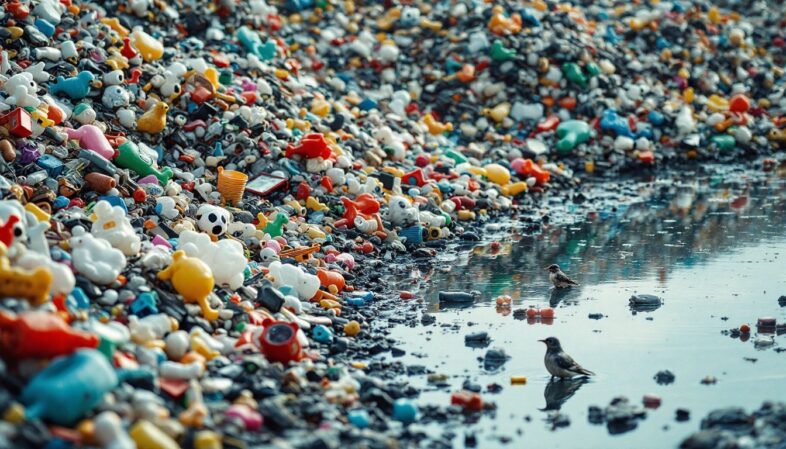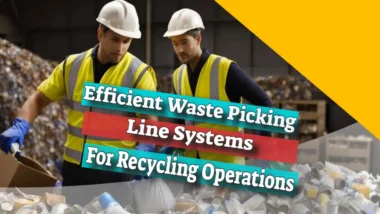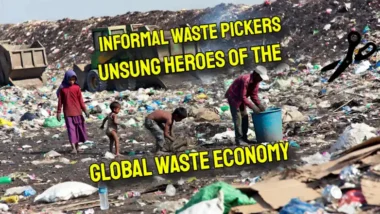The Shocking Truth: How Plastic Toys Are Damaging Our Environment
Every day, children play with toys that harm our planet. Plastic toys fill shelves and playrooms but also add to a big problem for the environment. One key fact stands out: plastic toys are mainly made from materials like polyvinyl chloride (PVC), which is bad for nature. 1 This blog will show you the harmful effects of plastic toys on our environment.
We'll explore how these toys hurt land, sea, and all living things in between. 2 You'll learn about better choices we can make to protect the Earth. The truth will surprise you—read on to find out more.
Key Takeaways
- Making plastic toys lets out a lot of bad gases and makes water dirty. This hurts our earth.
- Tiny bits of plastics from toys pollute the water and soil, which is bad for animals and people.
- Toys thrown away add toxic stuff to the ground and air, making it dangerous for living things.
- Plastic waste in oceans harms sea animals by trapping them or getting eaten as food.
- Choosing natural rubber, wood, or recycled toys helps protect our planet and keeps us safe.
The Environmental Impact of Plastic Toy Production

Making plastic toys harms our planet. It sends a lot of bad gases into the air and makes water dirty.
Greenhouse Gas Emissions
Every year, making plastic toys releases a lot of carbon dioxide into the air. For instance, 60 million Barbie dolls sold add up to emissions like burning 381 million gallons of petrol. 1 Lego also adds over one million tons of CO2 yearly but plans to cut this by using bioplastics soon.
Transporting these toys from place to place emits more gases. Moving Barbie dolls from China gives off 7% more greenhouse gases than sending them from Mexico. If we reduce how far these dolls travel, we can lower greenhouse gas emissions by 7% and acid rain causing gases by 25%.
Each step in making and moving toys has a big impact on our planet.

Water Pollution and How Microplastic and Nanoplastic is a Form of Water Pollution
Playing with plastic building bricks makes lots of tiny particles. 2 These are called microplastic and nanoplastic. They get into the water and pollute it. Scientists found out that putting together and taking apart toys creates these small bits.
These tiny plastics can carry bad stuff, like toxins, into the water. This makes the water dirty and unsafe for both people and animals. It's a big reason why we need to worry about how we use and throw away plastic toys. 3
How Microplastic and Nanoplastic Harms Humans and Wildlife
Microplastics and nanoplastics are everywhere – in our air, food, and water. These tiny particles can cause big problems for humans and wildlife. Humans eat seafood that contains these plastics. 4 This can lead to health issues like stress in our bodies, swelling, and even upset stomachs. Wildlife faces similar dangers when they get stuck with these plastics in their systems. 5
Tiny plastics don't stop there. They move through the food chain, adding up over time in bigger animals and possibly coming back to us when we eat fish or other seafood. The harm goes beyond just eating them; breathing air with microplastics also affects both people and animals' health around the world.
Next up: Consequences of Plastic Toys in Landfills
Consequences of Plastic Toys in Landfills
Plastic toys end up in trash dumps, and that's bad news. They leak harmful stuff into the ground….

Release of Toxic Chemicals
Toys in landfills break down and release dangerous chemicals. These include phthalates and heavy metals. 6 They get into the soil and water. This hurts our health and damages wildlife. 7 Burning toys is also bad. It sends toxic fumes like dioxins into the air, harming the ozone layer.
Microplastic pollution comes next from these broken-down toys. Tiny plastic bits spread in soil, hurting plants and animals that live there.
Every toy thrown away adds to a growing problem of pollution, affecting us all.
Microplastic and Nanoplastic Soil Contamination
Microplastics and nanoplastics cause soil contamination. These tiny pieces of plastic disrupt the natural cycle of nutrients in the ground. They can harm farming by affecting soil health and food production.
As microplastics build up, they introduce pollutants to the earth. This pollution makes it harder for crops to grow strong and healthy. Soil contaminated with microplastics may impact human food safety too.
When these substances mix into our environment, they carry harmful chemicals that affect both wildlife and people’s health. 8
In agroecosystems, the increasing amount of microplastics poses great risks. The type, shape, size, and abundance of these particles matter too; they all play a role in how much damage is done to ecosystems.
Soil with high levels of microplastic pollution struggles to support plant life effectively. Ultimately, this means less sustainable farming practices which can lead to increased waste from discarded plastic toys ending up in landfills or oceans over time.
Plastic Toys and Ocean Pollution
Plastic toys are a big problem for our oceans. They hurt marine animals and pollute the water… This pollution comes from small bits of plastic that break off and drift into the sea, harming creatures like fish and turtles.

Harm to Marine Life
Plastic toys harm marine life. Animals get trapped in plastic waste. This leads to injuries and starvation. Some fish eat microplastics, mistaking them for food. 10 These plastics can move up the food chain, affecting humans too.
Ghost gear from fishing adds to the problem, causing many injuries in ocean animals. 9
Next, we will discuss how plastic toys contribute to pollution in our oceans.
Contribution to Microplastic Pollution Microplastic and Nanoplastic
One of the most harmful effects of plastic toys to our environment occurs when plastic toys break down into tiny pieces called microplastics. These small bits pollute our water and soil. They come from larger plastic items as they degrade, but some are made on purpose. 11 Microplastics can carry harmful chemicals like bisphenol A (BPA) that affect both animals and humans.
Microplastics end up in oceans, rivers, and lakes. They harm marine life by getting into the food chain, causing great risk to wildlife. The COVID-19 pandemic increased this problem, thanks to the rise of disposable PPEs that added even more waste. 11 This pollution impacts children's health too as they play with these toys made from non-renewable resources like petroleum.
Sustainable Alternatives to Plastic Toys
Many toys today are made from plastic, but there are better options. Natural rubber and wooden toys are safe for kids and kinder to our planet. Upcycled and recycled toys also help reduce waste.
These choices support a more eco-friendly lifestyle. They show that fun can be sustainable too!
Natural Rubber and Wood Toys
Natural rubber toys are great for kids. They are soft, flexible, and free from toxic chemicals. 12 This makes them safe for teething babies. On the other hand, wooden toys offer durability and craftsmanship.
They are chemical-free and can last many years with proper care. 12
Bamboo toys also stand out; they are light, strong, biodegradable, and don't need pesticides to grow. Eco-friendly options like wool and cotton toys use organic materials as well. These toys break down easily without harmful dyes.
Next up: exploring recycled options in the toy industry!
Upcycled and Recycled Toys
Upcycled and recycled toys offer a great solution for reducing waste. These toys come from old plastic items, like bottles or broken toys, transformed into new ones. Mechanical recycling can cut carbon emissions by 3.6 kg per kg of plastic made. 13 This means less pollution and more eco-friendly options for kids.
Using 3D printing technology, makers create high-quality products from waste plastics. The strength of these items is just as good as brand-new materials. Parents can choose sustainable products that are kinder to the environment while still providing fun play experiences for their children. 14
Conclusion of our Article: Harmful Effects Of Plastic Toys To Our Environment
Plastic toys harm our planet. They pollute air, land, and water. Each year, millions of animals die from plastic waste. Alternatives like wooden or recycled toys can help reduce this damage.
Choosing eco-friendly options protects the environment for future generations.
FAQs on the Harmful Effects Of Plastic Toys To Our Environment
1. What's the environmental impact of plastic toys?
Plastic toys contribute to environmental pollution, from extraction of fossil fuels for their production to disposal in landfills or incinerators, emitting greenhouse gases and accelerating global warming.
2. How do plastic toys affect climate change?
When disposed, plastic toys can be incinerated or end up in landfills where they decompose slowly, releasing methane–a potent gas contributing to global warming. The manufacturing process also uses crude oil and emits carbon dioxide, increasing the global warming potential.
3. Can we make eco-friendly alternatives to traditional plastic toys?
Yes! Toymakers are now using recycled materials like water bottles or biodegradable materials instead of polycarbonate plastics and poly-vinyl chloride. This shift towards environmentally friendly choices helps reduce our carbon footprint and protect the environment.
4. Is recycling an effective solution for reducing the environmental impact of plastic toys?
Recycling is a step forward but it doesn't completely solve the problem due to issues with recyclability of certain types of plastics such as flexible ones used in some toys… Upcycling or choosing reusable options are better strategies towards zero waste.
5. Are there any regulations on toy production for environmental protection?
Environmental regulations vary globally but many countries are encouraging use of renewable materials over non-recyclable ones… Some brands voluntarily follow green practices by producing BPA-free, lead-free items or promoting circular economy models.
6. As consumers how can we help mitigate these detrimental effects?
Opting for green toys made from natural materials reduces demand for new plastics… Also buying second-hand from charity shops minimises accumulation while teaching kids about sustainable consumerism… Proper disposal also ensures less litter ends up polluting water bodies creating garbage patches.
References
- ^ https://environment-review.yale.edu/most-materials-are-recyclable-so-why-cant-childrens-toys-be-sustainable
- ^ https://www.chemistryworld.com/news/playing-with-plastic-toy-building-bricks-creates-microplastic-and-nanoplastic-pollution/4019504.article (2024-05-21)
- ^ https://www.ncbi.nlm.nih.gov/pmc/articles/PMC8714882/
- ^ https://www.ncbi.nlm.nih.gov/pmc/articles/PMC10375051/
- ^ https://www.sciencedirect.com/science/article/pii/S2772397624000042
- ^ https://www.theworldcounts.com/challenges/consumption/other-products/environmental-impact-of-toys
- ^ https://www.sciencedirect.com/science/article/pii/S0048969724041482
- ^ https://www.sciencedirect.com/science/article/pii/S0147651323013118
- ^ https://www.padstowsealifesafaris.co.uk/blog/plastic-pollution-on-marine-life/
- ^ https://www.wwf.de/fileadmin/fm-wwf/Publikationen-PDF/Plastik/WWF-Impacts_of_plastic_pollution_in_the_ocean_on_marine_species__biodiversity_and_ecosystems.pdf
- ^ https://pmc.ncbi.nlm.nih.gov/articles/PMC9920460/
- ^ https://www.bumbutoys.com/blog/wooden-toys/sustainable-alternatives-to-plastic-toys-eco-friendly-options-for-kids
- ^ https://www.sciencedirect.com/science/article/abs/pii/S0959652620322356
- ^ https://www.thegoodboutique.com/inspiration/the-impact-of-cheap-plastic-toys-on-the-environment?srsltid=AfmBOoq0p3CaXC7U1PsDo39TT-h_MoAZCd5Mt2LwbpoW9ja07XVtIkAd (2023-04-25)







